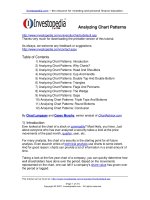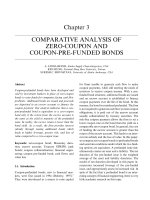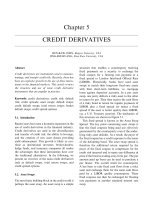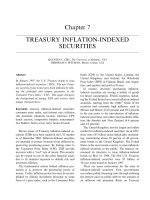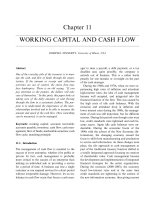Encyclopedia of chart patterns - Thomas n bulkowski
Bạn đang xem bản rút gọn của tài liệu. Xem và tải ngay bản đầy đủ của tài liệu tại đây (8.15 MB, 1,035 trang )
4366_FM.qxd
4/6/05
12:46 PM
Page iii
Encyclopedia
of
Chart Patterns
SECOND EDITION
Thomas N. Bulkowski
John Wiley & Sons, Inc.
4366_FM.qxd
4/6/05
12:46 PM
Page vi
4366_FM.qxd
4/6/05
12:46 PM
Page i
Encyclopedia
of
Chart Patterns
4366_FM.qxd
4/6/05
12:46 PM
Page ii
Founded in 1807, John Wiley & Sons is the oldest independent publishing
company in the United States. With offices in North America, Europe, Australia, and Asia, Wiley is globally committed to developing and marketing print
and electronic products and services for our customers’ professional and personal knowledge and understanding.
The Wiley Trading series features books by traders who have survived
the market’s ever-changing temperament and have prospered—some by reinventing systems, others by getting back to basics. Whether a novice trader,
professional, or somewhere in-between, these books will provide the advice
and strategies needed to prosper today and well into the future.
For a list of available titles, visit our Web site at www.WileyFinance.com.
4366_FM.qxd
4/6/05
12:46 PM
Page iii
Encyclopedia
of
Chart Patterns
SECOND EDITION
Thomas N. Bulkowski
John Wiley & Sons, Inc.
4366_FM.qxd
4/6/05
12:46 PM
Page iv
This book is printed on acid-free paper
Copyright © 2005 by Thomas N. Bulkowski. All rights reserved.
Published by John Wiley & Sons, Inc., Hoboken, New Jersey.
Published simultaneously in Canada.
No part of this publication may be reproduced, stored in a retrieval system, or transmitted in
any form or by any means, electronic, mechanical, photocopying, recording, scanning, or
otherwise, except as permitted under Section 107 or 108 of the 1976 United States
Copyright Act, without either the prior written permission of the Publisher, or authorization
through payment of the appropriate per-copy fee to the Copyright Clearance Center, 222
Rosewood Drive, Danvers, MA 01923, 978-750-8400, fax 978-646-8600, or on the Web at
www.copyright.com. Requests to the Publisher for permission should be addressed to the
Permissions Department, John Wiley & Sons, Inc., 111 River Street, Hoboken, NJ 07030,
201-748-6011, fax 201-748-6008, or online at />Limit of Liability/Disclaimer of Warranty: While the publisher and the author have used their
best efforts in preparing this book, they make no representations or warranties with respect to
the accuracy or completeness of the contents of this book and specifically disclaim any implied
warranties of merchantability or fitness for a particular purpose. No warranty may be created or
extended by sales representatives or written sales materials. The advice and strategies contained
herein may not be suitable for your situation. You should consult with a professional where
appropriate. Neither the publisher nor the author shall be liable for any loss of profit or any
other commercial damages, including but not limited to special, incidental, consequential, or
other damages.
For general information about our other products and services, please contact our Customer
Care Department within the United States 800-762-2974, outside the United States at 317572-3993 or fax 317-572-4002.
Wiley also publishes its books in a variety of electronic formats. Some content that appears in
print may not be available in electronic books. For more information about Wiley products,
visit our Web site at www.wiley.com.
Library of Congress Cataloging-in-Publication Data:
Bulkowski, Thomas N., 1957–
Encyclopedia of chart patterns / Thomas N. Bulkowski.—2nd ed.
p. cm. — (Wiley trading series)
Includes index.
ISBN-13 978-0-471-66826-8
ISBN-10 0-471-66826-5 (cloth)
1. Stocks—Charts, diagrams, etc. 2. Commodity futures—Charts, diagrams, etc.
3. Investment analysis. I. Title: Chart patterns. II. Title. III. Series.
HG4638.B85 2005
332.63′222—dc22
2004059094
Printed in the United States of America.
10 9 8 7 6 5 4 3 2 1
4366_FM.qxd
4/6/05
12:46 PM
Page v
To my parents, who continued to love me even after my homemade
rocket set the lawn on fire, and to my four-legged best friend,
Rusty, who saved my life; it grieves me that I couldn’t save yours.
4366_FM.qxd
4/6/05
12:46 PM
Page vi
4366_FM.qxd
4/6/05
12:46 PM
Page vii
Preface to the
Second Edition
On March 24, 2000, the financial world changed. No, that was not the date this
book first hit the store shelves, but the beginning of a bear market that lasted
1
2 ⁄2 years. Finally, I had bear market data to use for finding chart patterns!
After spending nearly 5 years recovering from the work needed to complete the first edition, I decided to undertake an update. I changed the editorial content of the book in small ways, but made substantial improvements in
others. Here is the list of the important changes:
• Bull and bear market statistics for complete coverage.
• Expanded statistics, all in a similar format:
Results Snapshot, at the start of each chapter shows the most
important numbers and surprises.
General statistics, including the average rise or decline, busted
pattern performance, and benchmark performance.
Failure rates, a list of ten breakpoints to show how often a pattern
fails.
Breakout and postbreakout statistics, showing performance
over the yearly price range, pullback rates, and performance after a
gap.
Frequency distribution of days to the ultimate high or low,
showing when the trend is likely to end.
Size statistics, describing how performance varies for pattern
height, width, and combinations of both.
Volume statistics, including volume trend, a new concept I call
volume shapes, and breakout day volume.
For best performance, a list of trading tips and where to find
them in each chapter.
vii
4366_FM.qxd
4/6/05
viii
12:46 PM
Page viii
Preface to the Second Edition
• More chart patterns. I added 14 new chart patterns.
• Event patterns. I added 9 new types of patterns, which I call event patterns. These include earnings surprises, drug approvals, store sales, and
stock upgrades and downgrades.
• More samples. I found over 38,500 chart pattern samples, more than
double the 15,000 used in the first edition, making many of the statistics rock solid.
• Keyed table entries. Each table entry appears in bold at the start of its
corresponding text discussion for easy locating.
• Glossary and methodology. Instead of peppering the text with repeated
explanations, a new chapter explains how I arrived at each table entry.
Thanks to the thousands who purchased the first edition. I am confident
that this second edition will help you become a more knowledgeable and successful trader.
THOMAS N. BULKOWSKI
January 2005
4366_FM.qxd
4/6/05
12:46 PM
Page ix
Preface to the
First Edition
When I was a little tyke I decided the easiest way to riches was to play the stock
market. It was, after all, a level playing field, a negative-sum game with somebody winning and somebody losing. (Hint: The winner is always the broker.)
All one had to do to win was pick stocks that went up and avoid stocks that
went down. Easy.
I kept this in mind when I graduated from Syracuse University with an
engineering degree and showed up early for my first professional job. Each
morning I cracked open the newspaper and plotted my stock picks on a piece
of graph paper taped to the wall. Bob, my office mate, used the same newspaper to select his stocks. I chose my selections after exhausting fundamental
research, but Bob simply closed his eyes, twirled his hand around, and plunged
his finger into the newspaper. When he opened his eyes and removed his finger, he announced another pick.
After several months of tracking both our selections, I made a startling
discovery: I was getting creamed. Bob’s random selections were beating the tar
out of my carefully researched choices. I also discovered something else: I was
learning a lot by paper trading.
With the hesitancy and distrust inherited from my parents, I studied two
dozen firms before making my final selection and first purchase: I opened a
money market account. The timing was excellent; I was earning over 17% on
my cash. At first glance, the return might imply a very risky investment but it
was not. The prime rate was, after all, at 21%.
Flush with success, I gathered my courage and opened a brokerage
account and began investing the few pennies I saved. Again, the timing was
excellent as I caught the beginning of a major bull market. I bought a stock at
a split-adjusted price of 88 cents and watched it go to $30 and change.
Lest you think that everything was easy, consider what happened. My
stock portfolio was growing by leaps and bounds, but my professional career
was about to take a turn for the worse. After switching careers more often than
ix
4366_FM.qxd
4/6/05
x
12:46 PM
Page x
Preface to the First Edition
I sometimes like to admit, I landed a job with a company I could finally call
home—a job that would last a lifetime, or so I hoped. Almost 6 months after
my 10-year anniversary with the company, I received a letter from the chairman. He congratulated me on my decade with the company and looked forward to even more success for me in the coming years.
Six weeks later I was laid off.
I took stock of the situation and decided that, at the age of 36, I had
enough. Newspapers term guys like me The Missing Million. We are the ones
who, for whatever reason, leave their jobs and decide not to go back into the
workforce. We retire. Everyone, and I mean everyone (with the notable exception of my cousin Mary Ann—bless her heart), thinks we are nuts. They are
right, of course!
For the longest time, I have been fascinated with technical analysis of
stocks. In the early years, I considered the little squiggles to be nothing short
of voodoo. Still, I was curious as to why the major brokerage houses were hiring technical analysts in droves. But I did not dare take my eye off the fundamentals simply because I did not know anything about the technicals. Then I
discovered Technical Analysis of Stocks and Commodities magazine. During my
lunch hour, I would take the elevator down to the library and read back issues.
Although I saw chart patterns in the stocks I bought, I never really attached
much significance to them. As some of my selections went sour, I began to view
chart patterns with more respect. The fundamentals always looked good, but
the technicals were signaling a trend change just as I was about to pull the trigger. The stocks I bought either lost money outright or I sold them too soon
and cut my profits short.
Perhaps this has happened to you. You do fundamental research on a stock
and then buy it, only to watch it go nowhere for a year or more. Even worse,
once you get in, the stock tumbles. Had you looked at the chart the answer was
always there. Prices pierced a trend line, a head-and-shoulders top appeared
out of nowhere, the relative strength index signaled an overbought situation. In
short, any number of technical indicators were screaming that a buy now
would cost you your shirt. But you never saw the signs.
You are not alone; I did the same thing for years. I eventually got so frustrated with the performance of my stock selections that I decided to do my own
research on technical analysis. I went to the library and read the same thing in
many books: A head-and-shoulders formation works most of the time. What
does that mean? Does it mean they are successful 51% of the time or 90% of
the time? No one had the answer. I was not willing to risk my hard-earned dollars on simple bromides. As an engineer I wanted hard, cold facts, not fuzzy
platitudes. So, I wrote this book.
At the back of the book is an Index of Chart Patterns. If you suspect your
stock is making a chart pattern but do not know what to call it, the Index of
4366_FM.qxd
4/6/05
12:46 PM
Page xi
Preface to the First Edition
xi
Chart Patterns is the first place to look. Page numbers beside each pattern
direct you to the associated chapter.
The chapters are arranged alphabetically in two sections; chart patterns
and event patterns. Within each chapter, you are first greeted with a “Results
Snapshot” of the major findings followed by a short discussion. Then, a
“Tour” invites you to explore the chart pattern. “Identification Guidelines,” in
both table form and in-depth discussion, make selecting and verifying your
choices easier.
No work would be complete without an exploration of the mistakes, and
the “Focus on Failures” section dissects the cause of failures. The all-important
“Statistics” section follows. How do you trade a chart pattern? That is what the
“Trading Tactics” and “Sample Trade” sections explore. The “For Best Performance” section includes a list of tips and observations on how to select better performing patterns.
If you have ever worked on a car or done some woodworking, then you
will recognize the importance of selecting the right tool for the job. You would
not want to use a flat-head screwdriver when a Phillips works better. Both do
the job but they are hardly interchangeable. Sometimes it is not a screwdriver
you should be using, but a chisel. Selecting the proper tools and knowing how
to use them is half the battle. This book is a lot like that, helping to sort the
wheat from the chaff. Sometimes a chart pattern is frightening enough that you
will want to take profits. At other times, the best trade that you can make is
none at all.
I cannot give you the experience needed to make money in the stock market using chart patterns. I can only give you the tools and say, “Go to work on
paper first.” That is the first step in developing a trading style that works for
you, one you are comfortable with, one that improves as you do. If you review
your paper trades, you will understand why a stop-loss order is more than a
tool for the professionals. You will improve your ability to predict support and
resistance levels that will, in turn, allow you to tighten your stops and get out
near the top, cut your losses short, and let your profits run. You will understand why the statistics in this book are useful for comparison purposes, but
your trading results may fall short. You may discover that your girlfriend loves
diamonds, but as a chart pattern, they are a lousy investment. One word says it
all. Experience.
Good luck.
THOMAS N. BULKOWSKI
December 1999
4366_FM.qxd
4/6/05
12:46 PM
Page xii
4366_FM.qxd
4/6/05
12:46 PM
Page xiii
Acknowledgments
Perhaps several times in your life, something occurs that alters its direction.
That happened to me several years ago when I brashly submitted my first article to Technical Analysis of Stocks and Commodities. Much to my surprise and
delight, the editor at the time, Thom Hartle, published the work. That single
event sent me spinning off in a new direction, another career.
Nearly a dozen articles later, I called Thom and chatted with him about
an idea for a book. He steered me to Pamela van Giessen, now editorial director for John Wiley & Sons, Inc., publisher of this book. A single e-mail of my
idea to her put a new set of wheels in motion. Simple words cannot express my
thanks to these two outstanding individuals.
This is a great book made better by the tireless efforts of Bernice Pettinato
of Beehive Production Services. She did more than shepherd a 2,000 page manuscript through production. She read it and edited it without dying of boredom
while making astute suggestions. Simply, she’s the best. Thanks, Bernice.
T. N. B.
xiii
4366_FM.qxd
4/6/05
12:46 PM
Page xiv
4366_FM.qxd
4/6/05
12:46 PM
Page xv
Contents
Introduction
PART ONE
1
Chart Patterns
9
1
Broadening Bottoms
11
2
Broadening Formations, Right-Angled and Ascending
28
3
Broadening Formations, Right-Angled and Descending
45
4
Broadening Tops
63
5
Broadening Wedges, Ascending
81
6
Broadening Wedges, Descending
98
7
Bump-and-Run Reversal Bottoms
115
8
Bump-and-Run Reversal Tops
132
9
Cup with Handle
149
10
Cup with Handle, Inverted
164
11
Diamond Bottoms
179
12
Diamond Tops
196
13
Double Bottoms, Adam & Adam
213
14
Double Bottoms, Adam & Eve
229
15
Double Bottoms, Eve & Adam
244
16
Double Bottoms, Eve & Eve
259
17
Double Tops, Adam & Adam
275
18
Double Tops, Adam & Eve
291
xv
4366_FM.qxd
4/6/05
xvi
12:46 PM
Page xvi
Contents
19
Double Tops, Eve & Adam
307
20
Double Tops, Eve & Eve
321
21
Flags
335
22
Flags, High and Tight
350
23
Gaps
362
24
Head-and-Shoulders Bottoms
374
25
Head-and-Shoulders Bottoms, Complex
390
26
Head-and-Shoulders Tops
405
27
Head-and-Shoulders Tops, Complex
421
28
Horn Bottoms
438
29
Horn Tops
451
30
Island Reversals
464
31
Islands, Long
480
32
Measured Move Down
496
33
Measured Move Up
510
34
Pennants
522
35
Pipe Bottoms
536
36
Pipe Tops
550
37
Rectangle Bottoms
563
38
Rectangle Tops
579
39
Rounding Bottoms
595
40
Rounding Tops
608
41
Scallops, Ascending
624
42
Scallops, Ascending and Inverted
639
43
Scallops, Descending
654
44
Scallops, Descending and Inverted
670
45
Three Falling Peaks
684
46
Three Rising Valleys
698
47
Triangles, Ascending
711
48
Triangles, Descending
730
4366_FM.qxd
4/6/05
12:46 PM
Page xvii
Contents
xvii
49
Triangles, Symmetrical
748
50
Triple Bottoms
765
51
Triple Tops
779
52
Wedges, Falling
795
53
Wedges, Rising
811
PART TWO Event Patterns
827
54
Dead-Cat Bounce
829
55
Dead-Cat Bounce, Inverted
844
56
Earnings Surprise, Bad
855
57
Earnings Surprise, Good
868
58
FDA Drug Approvals
880
59
Flag, Earnings
893
60
Same-Store Sales, Bad
908
61
Same-Store Sales, Good
921
62
Stock Downgrades
934
63
Stock Upgrades
950
Statistics Summary
965
Glossary and Methodology
982
Index of Chart and Event Patterns
993
Index
1001
4366_FM.qxd
4/6/05
12:46 PM
Page xviii
4366_FM.qxd
4/6/05
12:46 PM
Page xix
Encyclopedia
of
Chart Patterns
4366_FM.qxd
4/6/05
12:46 PM
Page xx
4366_00.qxd
2/23/05
11:28 AM
Page 1
Introduction
Jim is struggling.
He is the owner of JCB Superstores and his competitor across town is
beating him up; there is blood all over Jim’s ledger. He decides it is time to take
off the gloves: JCB goes public. He uses the money from the initial public
offering to buy his competitor and add a few more stores around town.
With a growing sales base, Jim’s clout allows him to negotiate lower
prices for the office supplies he is retailing. He passes on part of the savings to
his customers, while watching his margins widen, and plows the profits back
into building more stores.
Jim calls his friend, Tom, and tells him of his plans to expand the operation statewide. They chat for a while and exchange business tactics on how best
to manage the expansion. When Tom gets off the phone, he decides to conduct his own research on JCB. He visits several stores and sees the same thing:
packed parking lots, people bustling around with full shopping carts, and lines
at the checkout counters. He questions a few customers to get a sense of the
demographics. At a few stores, he even chats with suppliers as they unload their
wares. Back at the office, he does a thorough analysis of the financials and
looks at the competition. Everything checks out so he orders his trading partners to buy the stock at no higher than 10.
When news of the expansion plan hits the wires, the Street panics. It is,
after all, a soft economy and expanding willy-nilly when a recession looms is
daft, maybe even criminal, according to the pundits. The stock drops below 10
and Tom’s crew makes its move. They buy as much as they can without raising suspicion. The stock rises anyway. It goes back up to 11, then 12, and
rounds over at 13 before heading back down.
1
4366_00.qxd
2/23/05
2
11:28 AM
Page 2
Introduction
Several months go by and the economic outlook is as bleak as ever. The
stock eases down to 9. After Tom checks in with Jim for the latest public news,
Tom’s team buys more. It is an easy score because investors are willing to
dump the stock, especially as year-end tax selling approaches.
Six weeks later the company releases the sales numbers for JCB; they are
better than expected. The stock rises 15% in minutes and closes at 10.75. And that
is just for starters. Six months later, it’s clear the economy was never in danger of
entering a recession and everyone sees boom times ahead. The stock hits 20.
Years go by, the stock splits a few times, and the holiday season looms.
Tom interviews a handful of customers leaving JCB Superstores and discovers
that they are all complaining about the same thing: The advertised goods are
not on the shelves. Tom investigates further and discovers a massive distribution problem, right at the height of the selling season. JCB has overextended
itself; the infrastructure is simply not there to support the addition of one new
store each week.
Tom realizes it is time to sell. He tells his trading department to dump
the stock immediately but for no less than 28.25. They liquidate about a third
of their large holdings before driving the stock down below the minimum.
Since it is the holidays, everyone seems to be in a buying mood. Novice
investors jump in at what they consider a bargain price. The major brokerage
houses climb aboard and tout the stock, but Tom knows better. When the
stock recovers to its old high, his trading partners sell the remainder of their
holdings. The stock tops out and rounds over. During the next month and a
half, the stock drifts down, slowly, casually. There does not appear to be a rush
for the exits—just a slow trickle as the smart money quietly folds up shop.
Then news of poor holiday sales leaks out. There is a rumor about distribution problems, merchandising mistakes, and cash flow problems. Brokerage
firms that only weeks before were touting the stock now advise their clients to
sell. The stock plummets 39% overnight.
One or two analysts say the stock is oversold; it is a bargain and investors
should add to their positions. Many bottom fishers follow their brokers’ recommendation and buy the stock. Big mistake. The buying enthusiasm pushes
the price up briefly before a new round of selling takes hold. Each day the stock
drops a bit lower, nibbling away like waves washing against a castle of sand. In
2 months’ time, the stock is down another 30%.
The following quarter JCB Superstores announces that earnings will
likely come in well below consensus estimates. The stock drops another 15%.
The company is trying to correct the distribution problem, but it is not something easily fixed. It decides to stop expanding and to concentrate on the profitability of its existing store base.
Two years later, Tom pulls up the stock chart. The dog has been flat for
so long it looks as if its heartbeat has stopped. He calls Jim and chats about the
outlook for JCB Superstores. Jim gushes enthusiastically about a new retailing
concept called the Internet. He is excited about the opportunity to sell office

